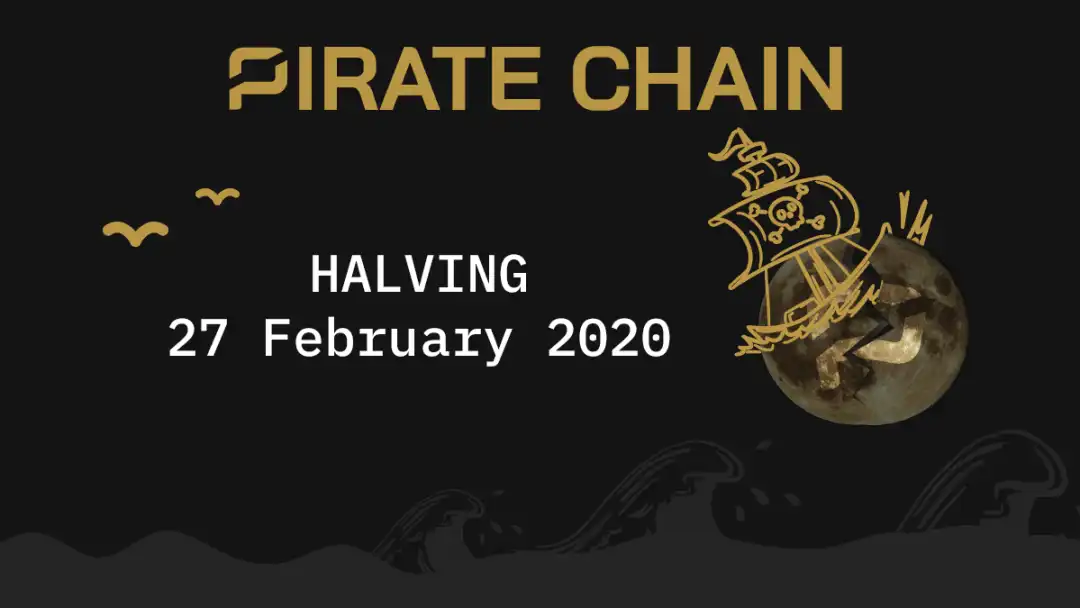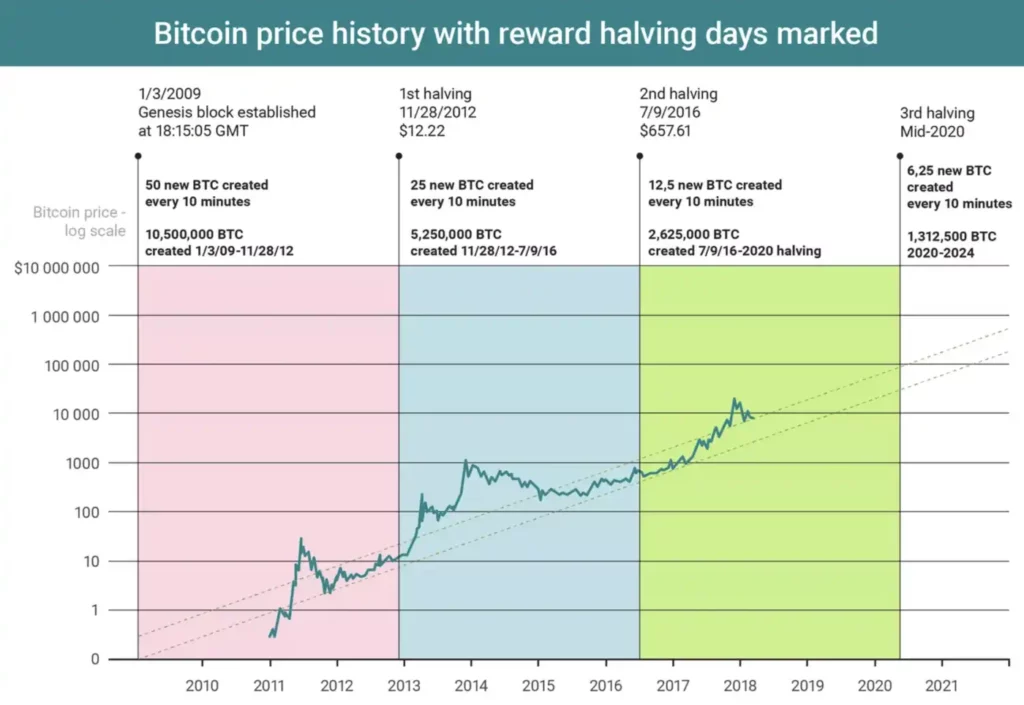~by wookie

graphic courtesy of pwnz
What is the “halvening”
Bitcoin and all blockchains derived from its code use a computation algorithm solved by “miners”, known as Proof-of-Work, to ensure the security of its blockchain. As compensation for their work, miners are rewarded with the transaction fees along with a predetermined number of newly created coins. This reward is necessarily reduced on a regular interval so that the total number of coins produced over time meets the fixed supply. Most blockchains use a 50% reduction strategy where the emitted block rewards is cut by half after a certain number of blocks. In the case of Bitcoin, the halving event, also colloquially referred to as “the halvening”, occurs every 210,000 blocks. Let's look at what the halvening entails and what it brings for the most private cryptocurrency, Pirate Chain.
“As scarce as truth is, the supply has always been in excess of the demand.”
~ Josh Billings
Scarcity of Supply
Any discussion of the halving of production necessarily raises the topic of scarcity. In the 1932 Essay on the Nature and Significance of Economic Science, British economist Lionel Robbins defined the study of Economics in terms of scarcity (1):
“That aspect of behavior which is the subject matter of Economics is, as we have seen, conditioned by the scarcity of given means for the attainment of given ends. It is clear, therefore that the quality of scarcity in goods is not an ‘absolute’ quality. Scarcity does not mean mere infrequency of occurrence. It means limitation in relation to demand.”
In The Bitcoin Standard, Saifedean Ammous refers to scarcity in terms of stock-to-flow ratio.
Stock is the amount of the material available in the world, and Flow is the annual production rate. Stock to flow ratio is a measure of abundance, mathematically, it is the amount of a commodity held in inventories divided by the annual production. Saifedean parallels bitcoin to gold in terms of their high stock to flow ratio. He posits that Bitcoin, like gold, are favorable commodities with high monetary value due to their high stock to flow ratio, unlike consumable commodities such as copper which has relatively lower stock to flow ratios.
Stock to Flow ratio
"The high stock-to-flow ratio of gold makes it the commodity with the lowest price elasticity of supply."
~ Saifedean Ammous, The Bitcoin Standard
Of all the precious commodities listed, Gold has the highest stock to flow ratio (SF) of 65.9, ie. 65.9 years of production is needed to achieve the current gold stock (Table 1). Platinum comes in second with a SF of 39.7 and Silver in third place with a SF of 20.7. This high SF makes them valuable commodities traded as monetary goods.
Table 1. Stock of flow ratio of common monetary metals and Bitcoin
| Stock (S) | Flow/yr (F) | SF ratio | Price | Market Capitalization | |
| Gold | 197,576 ton2 | 3,000 ton3 | 65.9 | $1580/oz | $11,011,487,401,920 |
| Silver | 560,000 ton4 | 27,000 ton4 | 20.7 | $15.65/oz | $309,141,336,000 |
| Platinum | 9400 ton5 | 237 ton6 | 39.7 | $970/oz | $321,628,332,000 |
| Bitcoin6 | 18,221,525 | 657,000 | 27.7 | $10,000 | $182,215,250,000 |
Bitcoin currently has a stock of 18.2 million coins and an emission rate of 657,000 per year, giving it a SF of 27.7. At this time, bitcoin has a stock to flow ratio higher than silver and close to platinum and gold. This places bitcoin in the similar territory to silver and gold, as a monetary commodity.
Price history at halving
Bitcoin has undergone two halving events to date. The price of BTC has steadily appreciated after each event. While two datapoints do not result in a predictable pattern, the trend today certainly suggests that the crypto market will see another new all-time high for bitcoin after the upcoming halving. It is not a question of “if”, but a question of “when”.
Table 2. Bitcoin post-halving price history
| Halving event | Halving date | Price at halving | New price record post-halving | Time to new high price post-halving | Price increase |
| 1st halving | Nov 28, 2012 | $12.31 | $994 | 369 days | 7974% |
| 2nd halving | July 9, 2016 | $650.63 | $19,798.68 | 526 days | 2943% |
Figure 1. Bitcoin halving chart11

A look at the marketcap leader of the privacy sector Monero
Monero has first mover’s advantage in the privacy sector. Launched on April 18th, 2014 Monero has enjoyed being the price leader amongst all privacy projects. XMR’s anonymization protocol relies on obfuscating users’ addresses and transactions. Essentially, it hides transaction details amongst a group of up to 14 others. This is known as the anonymity set. The key to Monero’s superiority over most of its competitors is its strategy of non-optional privacy.
Let’s take a look at the stock to flow ratio of Monero (Table 3). At today’s stock and emission rate, Monero enjoys a relatively high stock to flow ratio. As Bitcoin is king in the crypto market, and currently exerts over 50% dominance in the market, we see that BTC has a higher price despite a slightly lower SF than XMR.
Table 3. Stock of flow ratio of Bitcoin and Monero
| Stock (S) | Flow/yr (F) | SF ratio | Price | Market Capitalization | |
| Bitcoin6 | 18,221,525 | 657,000 | 27.7 | $10,000 | $182,215,250,000 |
| Monero7 | 17,446,391 | 502,026 | 34.8 | $85.00 | $1,482,943,235 |
Monero uses a method of continually decreasing rewards, hence there is no halvening, per se. For the sake of comparison, we will take the emission rate and total supply on December 31st of each year following Monero’s launch. Notably, Monero’s price has steadily increased and went parabolic with the crypto mania of 2017. The similar prices at year end of 2018 and 2019 despite increased SF is likely attributable to a return to the long term trend line.
Table 4. Chart of Monero’s annual stock to flow ratio on December 31st
| Months since launch | Rewards | XMR emission (Flow) | Total XMR Supply (Stock) | SF | |
| Dec 31st, 2015 | 20 | 75/10min | 3942000 | 10550399 | 2.6 |
| Dec 31st, 2016 | 32 | 45/10min | 2365200 | 13657989 | 5.7 |
| Dec 31st, 2017 | 44 | 27.5/10min | 1445400 | 15546907 | 10.7 |
| Dec 31st, 2018 | 56 | 17/10min | 893520 | 16686636 | 18.6 |
| Dec 31st, 2019 | 68 | 10/10min | 525600 | 17378892 | 33 |
Anticipating the SF of the most private and secure cryptocurrency, Pirate Chain
Pirate Chain has two main features that makes it at least the technological leader in the privacy sector. First, Pirate Chain employs zk-SNARKs, which is an anonymization protocol that does not reveal any details about the transactions. Pirate Chain is the first cryptocurrency to astutely employ a strategy of enforcing non-optional, private-only, zk-SNARKs protected addresses and transactions. Unlike Monero’s limited anonymity set of 15, every transaction in Pirate Chain’s history builds into an ever growing anonymity set. Second, Pirate Chain is secured by delayed Proof-of-Work (dPoW). Protected by dPoW, any potential attacker would have to first overcome both Bitcoin’s and Komodo’s blockchains. There is no comparable technology today in terms of blockchain security.
Let’s take a look at the stock to flow ratio of Pirate Chain. We are currently in the post-halving 1 phase with a stock to flow ratio of 3. In a few days, after the second halving, the SF will increase to 7. In fact, in 2020, Pirate Chain will experience two halvings, the next event occurring nine months later, in November. Notably, by the 4th halving (estimated to occur in August 2021), Pirate Chain will be at a stock-to-flow ratio comparable Monero today.
Table 4. ARRR mining rewards and stock-to-flow ratio post halving for the next 10 years
| Halving date | Rewards | ARRR emission (Flow) | Total ARRR Supply (Stock) | SF | |
| Genesis | 256 | 99554560 | 99554560 | 1.0 | |
| post-halving 1 | 5/30/19 | 128 | 49777280 | 149331840 | 3.0 |
| post-halving 2 | 2/27/20 | 64 | 24888640 | 174220480 | 7.0 |
| post-halving 3 | 11/23/20 | 32 | 12444320 | 186664800 | 15.0 |
| post-halving 4 | 8/20/21 | 16 | 6222160 | 192886960 | 31.0 |
| post-halving 5 | 5/17/22 | 8 | 3111080 | 195998040 | 63.0 |
| post-halving 6 | 2/11/23 | 4 | 1555540 | 197553580 | 127.0 |
| post-halving 7 | 11/8/23 | 2 | 777770 | 198331350 | 255.0 |
| post-halving 8 | 8/4/24 | 1 | 388885 | 198720235 | 511.0 |
| post-halving 9 | 5/1/25 | 0.5 | 194442.5 | 198914677.5 | 1023.0 |
| post-halving 10 | 1/26/26 | 0.25 | 97221.25 | 199011898.8 | 2047.0 |
| post-halving 11 | 10/23/26 | 0.125 | 48610.625 | 199060509.4 | 4095.0 |
| post-halving 12 | 7/20/27 | 0.0625 | 24305.3125 | 199084814.7 | 8191.0 |
| post-halving 13 | 4/15/28 | 0.03125 | 12152.6875 | 199096967.4 | 16383.0 |
| post-halving 14 | 1/10/29 | 0.01563 | 6076.359375 | 199103043.7 | 32766.8 |
| post-halving 15 | 10/7/29 | 0.00781 | 3038.1875 | 199106081.9 | 65534.5 |
| post-halving 16 | 7/4/30 | 0.00391 | 1519.097656 | 199107601 | 131069.7 |
Pirate Chain’s current marketcap is $7,978,821. Monero has a current marketcap of $1,313,927,140 (based on February 20th, 2020 data from coingecko), and an all-time high marketcap of $8,411,254,067. Modeling the sector price market leader, we may see a conservative 164-fold price increase, with minimum target of $8.72 / ARRR based on the current market. Based the all-time high value of the sector market leader and using the total estimated supply of 200 million, that places a potential target price of $42.05 / ARRR.
The Strength of Pirate Chain
Pirate Chain has proven excellence in privacy technology. Even Monero’s admin on telegram, Monero’s devs at MoneroKon, ZCash and Monero on twitter have all publicly praised Pirate Chain for its superior anonymity set and strong privacy. Nik Patel (@cointradernik on twitter) published a highly complimentary review particularly noting, “More impressive is the genuine and palpable excitement the community has for PirateChain; if I’m honest, this community (at least within Discord) seems to be one of the most engaged I have come across. This is critical in the longevity of a project (13).” The community has grown significantly since the report and continues delivering on many new developments. From a fundamental perspective, Pirate Chain has the potential to match the marketcap of Monero.
Historically, as we have seen with BTC, XMR and monetary commodities such as gold and silver, times of low stock to flow ratios are the best opportunities for accumulation. Based on the current stock to flow ratio, 2020 is best time to accumulate ARRR.
“With all the abundance we have of computers and computing, what is scarce is human attention and time.”
~Satya Nadella, CEO Microsoft
Lastly, I leave you with this thought about what I believe a currency should be and what a CryptoCurrency can be:
As the leading cryptocurrency with the best privacy, Pirate Chain is the closest approximation to the US dollar in terms of anonymity and also boasts the sound fiscal policy of Bitcoin with programmed scarcity.
References:
- https://is.muni.cz
- https://www.gold.org
- https://www.gold.org
- https://www.statista.com
- https://sdbullion.com
- https://platinuminvestment.com
- https://www.blockchain.com/charts
- https://bitinfocharts.com/monero
- https://piratechain.com/mining/
- https://explorer.piratechain.com
- https://ihodl.com
- https://twitter.com/wookie25/




Great content! Super high-quality! Keep it up! 🙂
Nice article 🙂
Also why I'm bullish about the halving:
Anyone expecting a sharp increase because of the halving is just relying on speculation. The "rational" result of a halving is simply reduced sell pressure which can/will result in a slow price increase over time, and imo ARRR is a perfect candidate for this.
Pirate has mostly strong holders which is also the reason of the - compared to other coins with roughly the same market cap - usually rather low trading volume, even though the coin emission is currently still very high. There are rarely big sell walls, rarely any flash dump due to disappointment or what ever. The sell side looks quite steady to me, with every week getting put up roughly the same amount of coins for sale. Both of these points combined are imo good indicators that a big part of the sell pressure is caused by miners/coin emission. If the newly mined coins per DAY are reduced by ~92k, I think, we will see a noticable reduction of the sell pressure which can easily result in a decent price increase over time.
I am proud to witness this moment in time because in 3 years from now people will wish they were mining ARRR Pirate Chain when the block reward was at this size.
Very nice work Wookie...
This article had me drooling like a dog! I love this community, and am incredibly tempted to start mining. I believe ARRR will take off, no doubt!
Nice explanation. Have to agree with the quotes on the Pirate Chain community, it's off the hook.
[…] wookie. (2020). The Pirate Chain Halvening. Retrieved from https://piratechain.com/the-pirate-chain-halvening/ […]